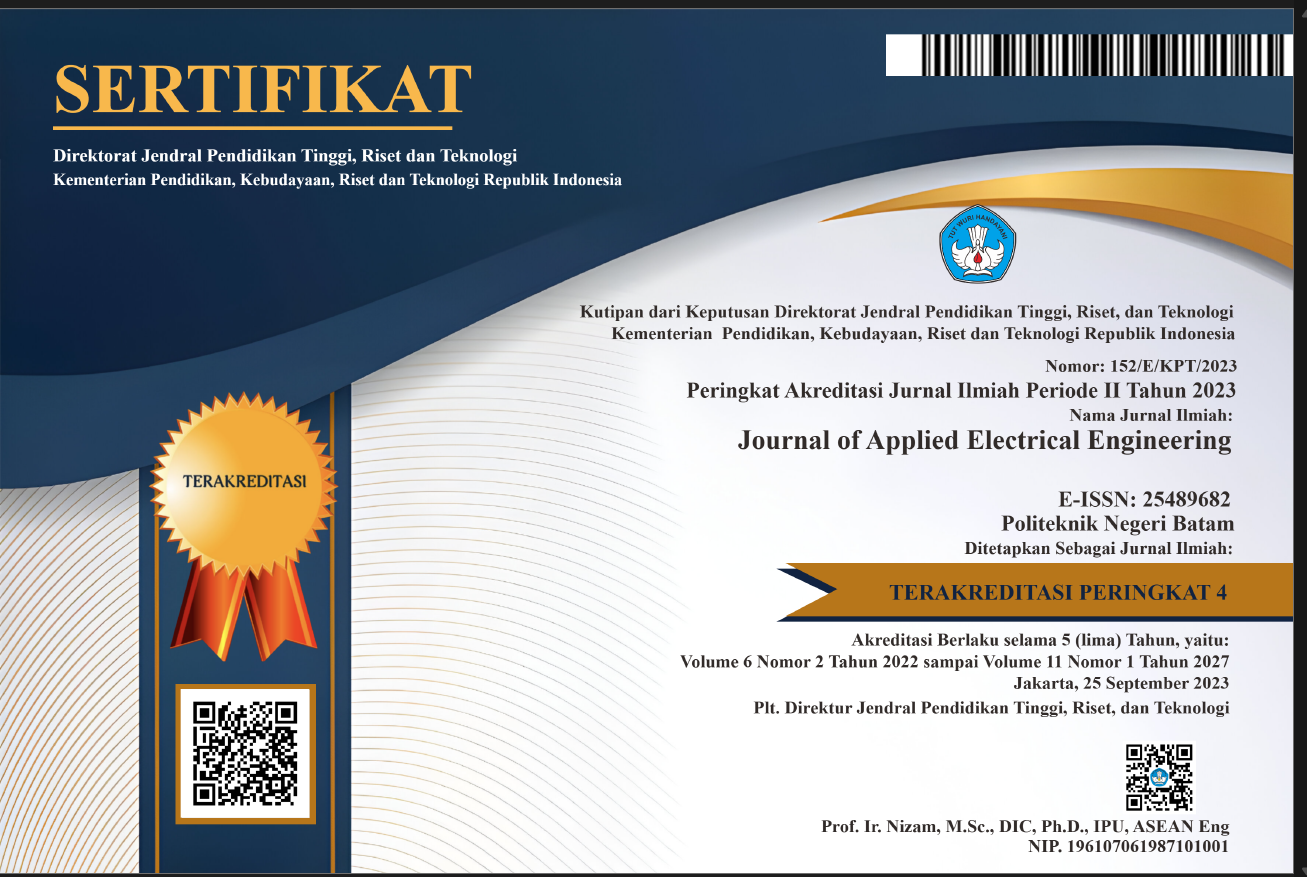Penerapan Komunikasi Nirkabel LoRa pada Sistem Pencatat Kehadiran Portabel
DOI:
https://doi.org/10.30871/jaee.v5i2.3096Keywords:
nirkabel, LoRa, pencatat kehadiran, portabelAbstract
Long Rang Access (LoRa) merupakan bagian dari teknologi Low Power Wide Area Network (LPWAN) yang banyak digunakan karena memiliki karakteristik berdaya rendah dan dapat menjangkau area yang jauh secara nirkabel. Pada penelitian ini telah dilakukan penerapan komunikasi nirkael LoRa pada sistem pencatat kehadiran portabel yang dapat digunakan dosen dan dan karyawan serta mahasiswa dalam merekam presensi saat beraktifitas di luar ruangan. Setelah dilakukan instalasi dan konfigurasi, dilakukan pongujian baik di dalam maupun di luar area kampus Politeknik Negeri Batam. Terdapat sembilan titik lokasi pengujian di dalam area kampus dan delapan titik lokasi pengujian di luar area kampus. Dengan menggunakan LoRa yang bekerja pada frekuensi 915 MHz, set SF=7 dan BW=125 KHz, didapatkan jangkauan terjauh hingga 456,01 meter. Keberhasilan penerimaan data dipengaruhi oleh jarak; banyak rintangan seperti beton, kaca, pepohonan dan gedung-gedung tinggi disekitar titi pengujian; frekuensi; dan bentuk antenna. Secara umum, komunikasi nirkabel LoRa dapat diterapkan pada sistem pencatat kehadiran portabel, namum masih terdapat ruang untuk pengembangan kedepannya terutama pada optimalisasi area jangkauan.
Downloads
References
M. Centenaro, L. Vangelista, A. Zanella, and M. Zorzi, "Long-range communications in unlicensed bands: the rising stars in the IoT and smart city scenarios," IEEE Wireless Communications, vol. 23, no. 5, pp. 60"“67, Oct. 2016, doi: 10.1109/MWC.2016.7721743.
F. A. R. Mu'amar Wildan, E. A. Z. Hamidi, and T. Juhana, "The Design of Application for Smart Home Base on LoRa," in 2020 6th International Conference on Wireless and Telematics (ICWT), Sep. 2020, pp. 1"“6. doi: 10.1109/ICWT50448.2020.9243648.
K. Tzortzakis, K. Papafotis, and P. P. Sotiriadis, "Wireless self powered environmental monitoring system for smart cities based on LoRa," in 2017 Panhellenic Conference on Electronics and Telecommunications (PACET), Nov. 2017, pp. 1"“4. doi: 10.1109/PACET.2017.8259970.
S.-Y. Wang et al., "Performance of LoRa-Based IoT Applications on Campus," in 2017 IEEE 86th Vehicular Technology Conference (VTC-Fall), Sep. 2017, pp. 1"“6. doi: 10.1109/VTCFall.2017.8288154.
A. Kurniawan, "Pembuatan Sistem Presensi Karyawan Berbasis Mikrokontroler NodeMCU ESP8266 Terintegrasi Web di Qiblat Indonesia," Laporan Akhir, Program Studi Teknik Komputer, Sekolah Vokasi Institut Pertanian Bogor, Bogor, 2020.
M. Diana, R. Nazir, and A. Rufiyanto, "Harvesting RF Ambient Energy dari End Device LoRa (Long Range Access)," JURNAL INFOTEL, vol. 9, no. 4, Art. no. 4, Nov. 2017, doi: 10.20895/infotel.v9i4.282.
J. Haxhibeqiri, E. De Poorter, I. Moerman, and J. Hoebeke, "A Survey of LoRaWAN for IoT: From Technology to Application," Sensors, vol. 18, no. 11, Art. no. 11, Nov. 2018, doi: 10.3390/s18113995.
"Arduino Shield featuring LoRa® technology." https://www.dragino.com/products/lora/item/102-lora-shield.html (accessed Jun. 22, 2021).
"LG02 Dual Channels LoRa IoT Gateway." https://www.dragino.com/products/lora-lorawan-gateway/item/135-lg02.html (accessed Jun. 22, 2021).
"In-Depth: What is RFID? How It Works? Interface RC522 with Arduino," Last Minute Engineers, Jul. 30, 2018. https://lastminuteengineers.com/how-rfid-works-rc522-arduino-tutorial/ (accessed Jun. 22, 2021).
"Grove - Fingerprint Sensor - Seeed Wiki." https://wiki.seeedstudio.com/Grove-Fingerprint_Sensor/ (accessed Jun. 22, 2021).
"Panel Surya 10 WP Shinyoku Polycrystalline," panel surya jakarta, panel surya murah, Panel Surya, Harga Panel Surya, Panel Tenaga Surya, Harga Tenaga Surya, Jual Panel Surya, May 26, 2015. https://panelsuryajakarta.com/panel-surya-10-wp-shinyoku-polycrystalline/ (accessed Jun. 22, 2021).
"Sunix® 10A 12V/24V Solar Charge Regulator Intelligent Solar Charge Controller, Display Overload Protection Temperature Compensation: Amazon.co.uk: Lighting." https://www.amazon.co.uk/Intelligent-Controller-Protection-Temperature-Compensation/dp/B01J5A61B2 (accessed Jun. 22, 2021).
Downloads
Published
How to Cite
Issue
Section
License
Authors who publish with this journal agree to the following terms:
- Authors retain copyright and grant the journal right of first publication with the work simultaneously licensed under a Creative Commons Attribution License (Attribution-ShareAlike 4.0 International (CC BY-SA 4.0) ) that allows others to share the work with an acknowledgment of the work's authorship and initial publication in this journal.
- Authors are able to enter into separate, additional contractual arrangements for the non-exclusive distribution of the journal's published version of the work (e.g., post it to an institutional repository or publish it in a book), with an acknowledgment of its initial publication in this journal.
- Authors are permitted and encouraged to post their work online (e.g., in institutional repositories or on their website) prior to and during the submission process, as it can lead to productive exchanges, as well as earlier and greater citation of published work (See The Effect of Open Access).
Open Access Policy
This journal provides immediate open access to its content on the principle that making research freely available to the public supports a greater global exchange of knowledge. Its free availability on the public internet, permitting any users to read, download, copy, distribute, print, search, or link to the full texts of these articles, crawl them for indexing, pass them as data to software, or use them for any other lawful purpose, without financial, legal, or technical barriers other than those inseparable from gaining access to the internet itself.













